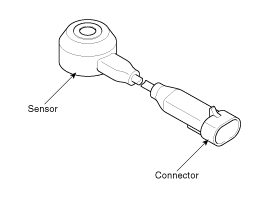 Hyundai Equus: Knock Sensor (KS) Description and Operation
Second generation VI (2009Ц2024) / Hyundai Equus VI 2009-2024 Service Manual / Engine Control/Fuel System / Engine Control System / Knock Sensor (KS) Description and Operation
Hyundai Equus: Knock Sensor (KS) Description and Operation
Second generation VI (2009Ц2024) / Hyundai Equus VI 2009-2024 Service Manual / Engine Control/Fuel System / Engine Control System / Knock Sensor (KS) Description and Operation
Second generation VI (2009Ц2024) / Hyundai Equus VI 2009-2024 Service Manual / Engine Control/Fuel System / Engine Control System / Knock Sensor (KS) Description and Operation
| Description |
Knocking is a phenomenon characterized by undesirable
vibration and noise and can cause engine damage. Knock Sensor (KS) is
installed on the cylinder block and senses engine knocking.
When knocking occurs, the vibration from the cylinder block
is applied as pressure to the piezoelectric element. When a knock
occurs, the sensor produces voltage signal. The ECM retards the ignition
timing when knocking occurs. If the knocking disappears after retarding
the ignition timing, the ECM will advance the ignition timing. This
sequential control can improve engine power, torque and fuel economy.

 Camshaft Position Sensor (CMPS) Repair procedures
Camshaft Position Sensor (CMPS) Repair procedures
Inspection
1.
Check the signal waveform of the CMPS and CKPS using the GDS.
Specification: Refer to УWave FormФ
Removal
Х
DONТT remove the camshaft position se ...
 Knock Sensor (KS) Specifications
Knock Sensor (KS) Specifications
Specification
ItemSpecificationCapacitance (pF)950 ~ 1,350
...
See also:
Rear Disc Brake Repair procedures
Removal
1.
Remove the rear wheel & tire.
Tightening torque :
88.3 ~ 107.9 N.m (9.0 ~ 11.0 kgf.m, 65.1 ~ 79.6 lb-ft)
2.
Loosen the hose eye-bolt (B) and caliper mounting bolts (C), th ...
Fuse/relay panel description
Inside the fuse/relay panel covers, you can find the fuse/relay label describing
fuse/relay name and capacity.
✽ NOTICE
Not all fuse panel descriptions in this manual may be applicable to ...
Shift Lever Repair procedures
Removal
1.
Remove the center console.
(Refer to Body - " Floor Consol")
2.
Disconnect the sports mode connector (A).
3.
Remove the shift cable assembly (A) from the shift lever assembl ...
Categories
Hyundai Equus Manuals
© 2011-2024 Copyright www.heqmanual.com
